ron-t kayaking blog
10 February 2014 ............ Around Cemaes
We had another few hours of quiet weather, so I took the opportunity to go back to Cemaes, this time with the cut down Delapre blades.
It was Neaps, about halfway through the ebb tide, and although the weather was quiet, there was another front forecast, with the west wind rising through the day.
It was pretty much the same as last time - I started of with a rolling and self rescue session, to see how this smaller blade would work.
Rolling was okay, but I did feel that the rather angular shape of the blade meant that the blade didn`t flow nicely through the water.
Doing a re-entry and roll-up took a bit more of an effort than it does with my usual blades, but I got up okay.
After that I headed out and along the coast towards Dinas Gynfor again.
Around Old Quarry Point there was a powerful swell, with some big surges of water up onto the rocks.
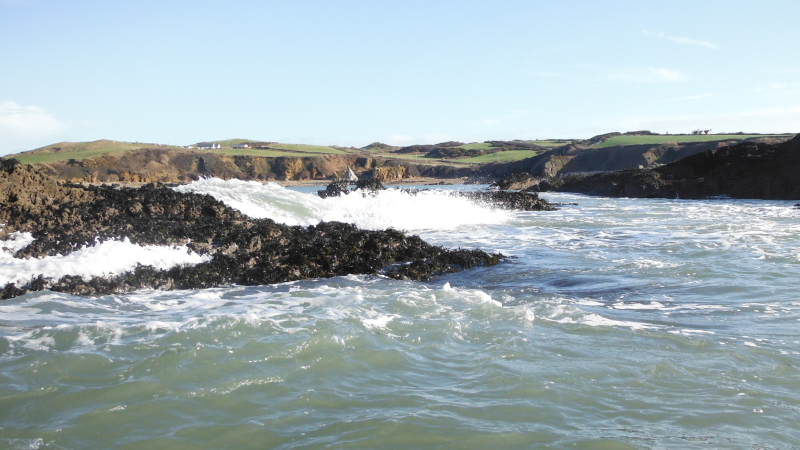
However as I made my way further along the coast, the swell actually got less, and I paddled pretty much straight out towards Dinas Gynfor.
Sitting beside the first un-named headland, looking out to Middle Mouse - today it was in sunshine.
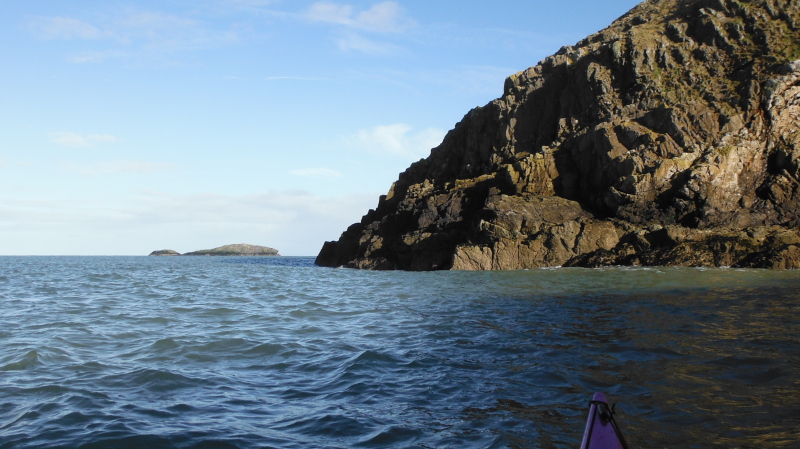
However I was getting hungry by the time I got to Porth Llanlleiana, so I went in for a lunch break, and sat in the sun.
It was almost like summer - apart from the temperature - the view from my lunch spot.
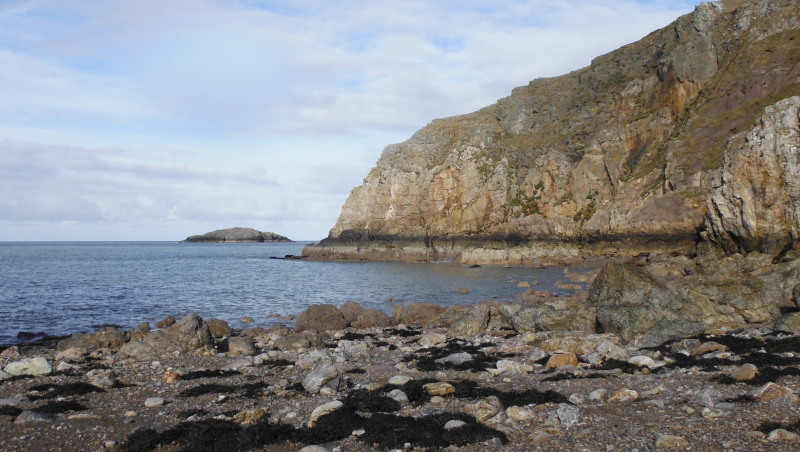
At least I started by sitting in the sun - within ten minutes or so, the sun was getting covered by increasing amounts and thickness of cloud.
After lunch, I headed round to Dinas Gynfor - there was a lot more sea coming through between the headland and the outlying rock than there usually is.
However as it was Neaps, there wasn`t much of a current flow past the headland, the sea further out was looking okay, so I headed out to Middle Mouse.
Further out, and I started to get the west wind that was now starting to show itself, so I stopped, re-assessed the conditions, and decided to carry on.
The sea was perhaps a bit bigger than last time, however I was quite comfortable in it, and eventually got to Middle Mouse.
As I got closer I could see that there were a lot less birds than last time - do they head inland when a storm is coming ?
The other thing I could see was a distinct tide race off the southwest corner of Middle Mouse - I crossed through it into the quieter water beside the island, then headed back across it, and headed back towards the mainland.
I am not sure, but I think the tide race was the start of the flood tide - it would have been about five hours after high water, and the tides along that coast turn before high and low water.
Normally Middle Mouse has a distinct tail caused by the island interrupting the tidal flow - during ebb tides, the tail is out to the west, and during flood tides, it is out to the east.
So a tide race off to the side is probably a transitory condition during "slackwater" - the water certainly isn`t slack !
I didn`t head straight for the coast, I headed more diagonally for Cemaes, however after a while, I decided I would stay out, and head across to Wylfa Head inside of going back into Cemaes.
My progress was fairly slow, as I think by now I was paddling against the flood tide, as well as against the wind, but as it is 2.6 km`s from Middle Mouse to Wylfa Head, I guess it is always going to take a while.
In the later part of the crossing, I was watching a rain cloud out to the north, hoping it wasn`t coming my way.
A rainbow started to grow just beside it - it wasn`t the brightest rainbow I have ever seen, and it was quite a distance away, but the picture has turned out better than I expected.
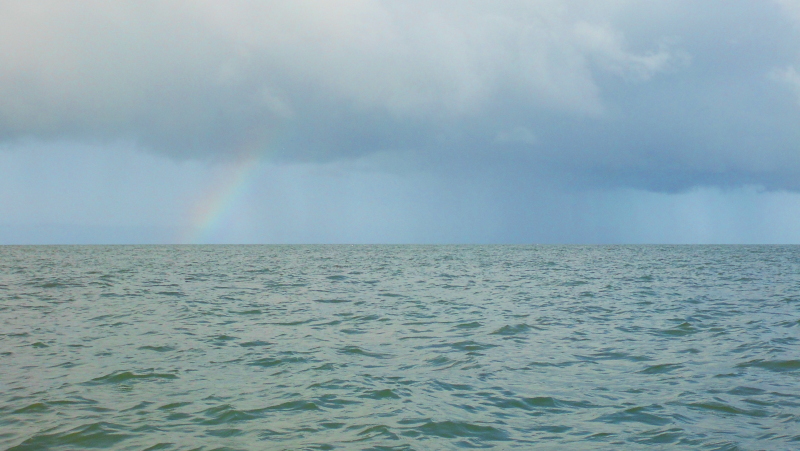
By now I could see the detail in the easterly point of Wylfa Head -
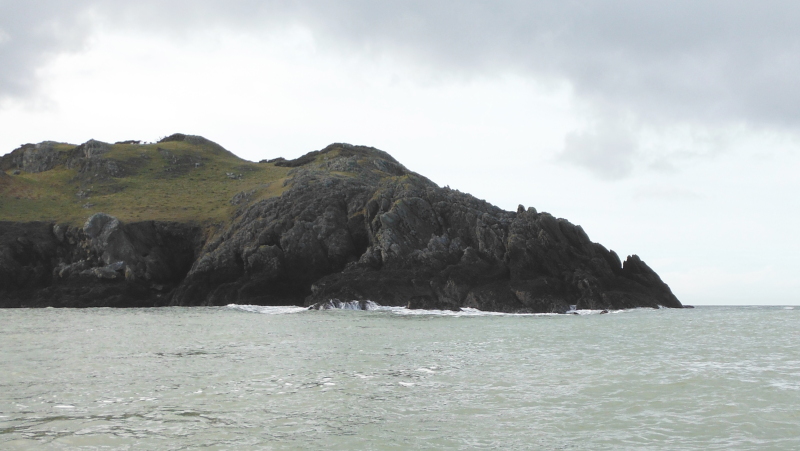
Looking back at Llanbadrig Head and the first un-named headland.
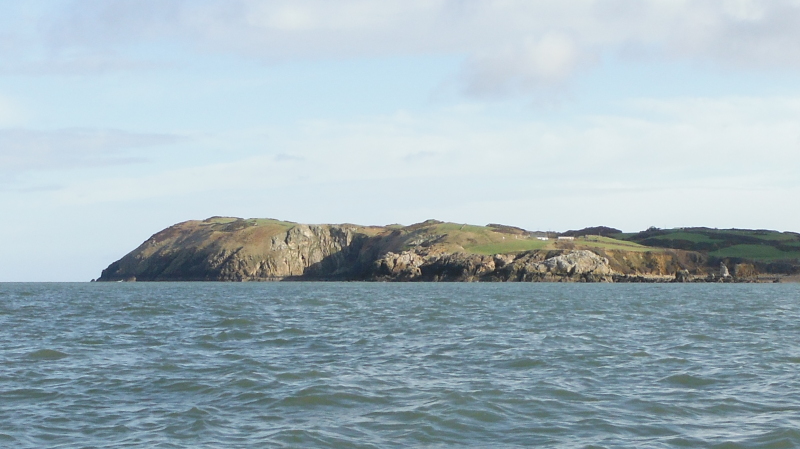
Heading round the point, and I`m beginning to see the swell out beyond Wylfa Head.
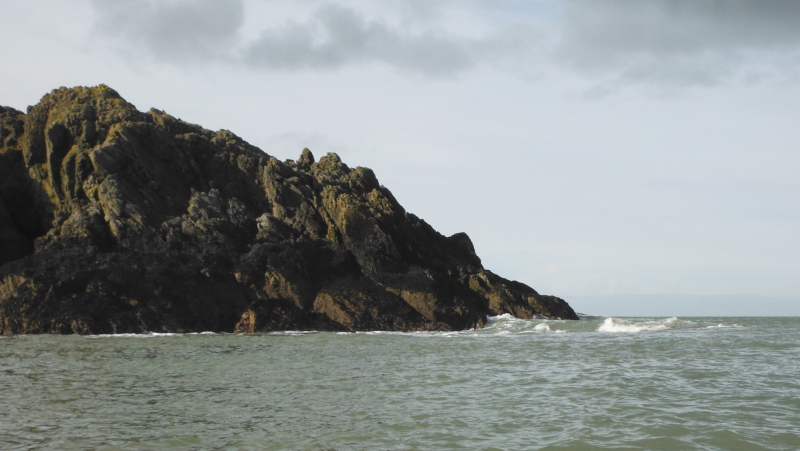
Wylfa Head is a long north facing headland that is very exposed to the west, the north, and the east - and it picks up everything the sea can throw at it - so it was quite lumpy at times.
This is looking westwards along the headland.
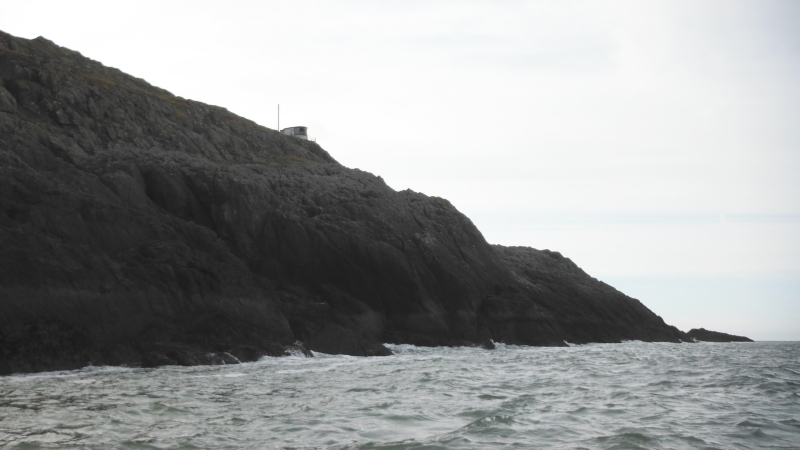
Along at the west end of Wylfa Head, the sea was quite lively, with the swell climbing up the rocks - the Skerries have just sneaked into the second picture, and I think that the two birds had other things on their mind, rather than the size of the swell.
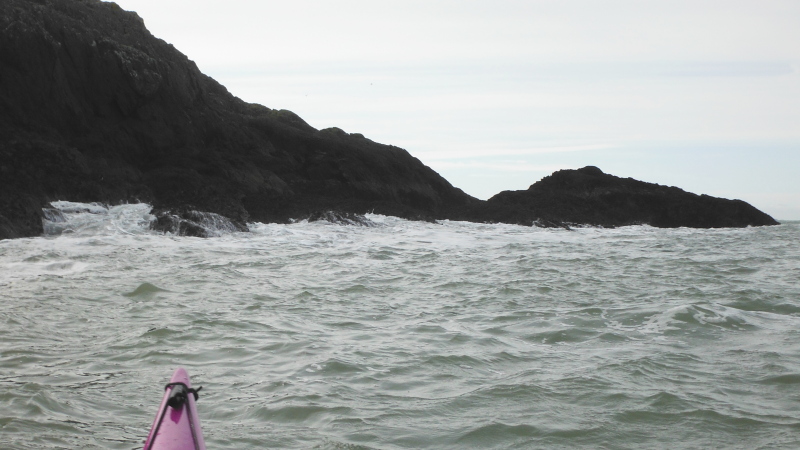
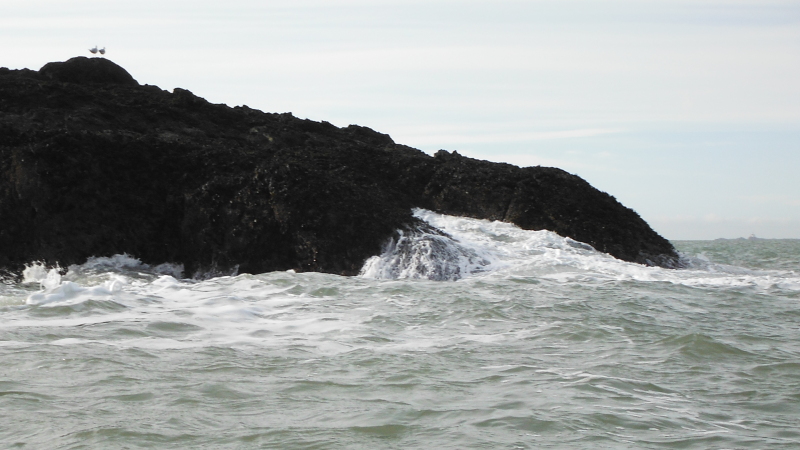
The swell was bigger, and the sea rougher, at the west end of the headland - probably because it was the flood tide, and the westerly point was the first part of the headland to catch it - the sea here was a lot bigger than on any other part of the whole trip.
Something that comes to mind - during an ebb tide, Wylfa Head has a sneaky trick up its sleeve to catch you out - you paddle out from Cemaes, and round the easterly point of Wylfa Head, and you are in quite calm water that is slowly drifting westwards.
The water slowly accelerates, and after a wee while, you notice a tide race off to your right.
The trouble is, it doesn`t stay off to your right, it gradually gets closer and closer to the shore, and you realise that you are trapped between the rocks and the tide race, and there is no escape - the only way to go is through the race.
I found this out a while ago, and I am afraid that at this point I can`t remember at what point in the ebb tide I was there - it may not happen all the way through the ebb tide, I can`t say.
At the far end of the headland, I turned and headed back - this is looking eastwards back along the headland.
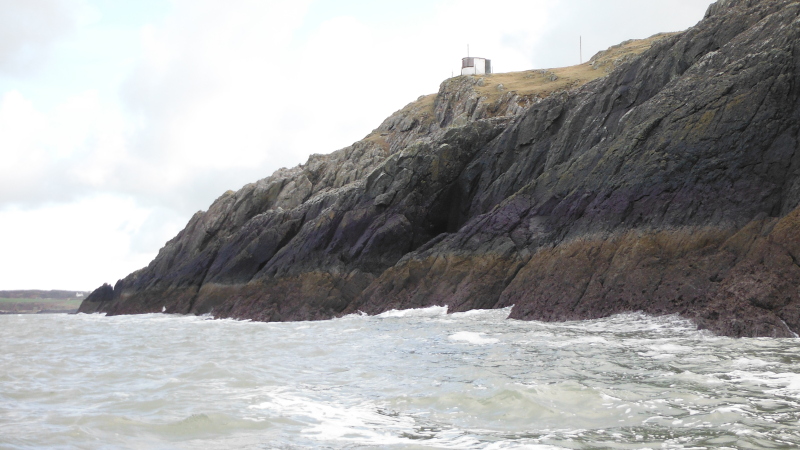
Round the easterly point and into the shelter - and that was when the battery in my camera died - so no more pictures.
One of the nice things about the stretch of coast between Cemaes and Wylfa Head is that you are sheltered from the west wind, and Porth-y-Ogof - tucked in at the back of Wylfa head - is very sheltered, and a good place to stop.
Time for another tea break, and some custard doughnuts !
Just as I landed, I looked at the top of the cliffs above the back of the beach, and sitting just at the end a stone wall above the cliff was a big raptor - I don`t know enough about birds to try and guess what it was, but it seemed to be a lot bigger than the buzzards that you sometimes see sitting on posts.
Sadly, I couldn`t try and photograph it - it was a fair distance away, so the picture might not have worked anyway, but it would have been good to have tried.
The coastline from Porth-y-Ogof down to the next bay Porth-y-Wylfa isn`t particularily interesting, but from Porth-y-Wylfa right round almost into Cemaes harbour can be magic for rock hopping, and it was excellent fun on this trip.
It may be sheltered from a west wind, but it certainly isn`t sheltered from any swell that is around, and it can be a wild bit of coastline if the sea is from the north or east.
On this occasion there was just the right level of swell coming in to provide lots of fun, without it being silly.
At one point I went through a gap, and had to immediately turn hard right to get out of the channel - and that was when the swell produced a big hole, and my boat jammed - the bow up on one rock, the stern up on another one - what on earth do I do now ?
I sat there for a what seemed like a long time but was probably only a few seconds, and a big wave came in, lifted up the bow, I whipped it round over the rock, and got free. It was most entertaining.
It was quite sad when I ran out of rocks, and headed into the beach, although I was getting quite cold by then, as I was wet from my self rescues earlier.
My cut down Delapre blades did okay but I think they are fairly sticky, they didn`t flow through the water nicely.
I didn`t notice any deficiency in them when I was rock hopping, but on the other hand, I didn`t feel that my cadence was any faster when I was I doing the various crossings than it would have been with my normal paddle.
This is a bit surprising, as they are some 190 cms² less in area than my normal blades.
So it must be to do with the shape - digging around on the web, I see a picture emerging that the drag produced by a blade is not only dependent on the area of the blade, but also on its shape.
It seems to be that for blades of the same area - a circular blade produces the least drag, and long thin blade ( think Greenland paddle ) produces the most drag.
Euro blades come inbetween these two.
So this theory suggests that a Greenland paddle, with its long thin shape, produces more drag than a Euro blade, so in normal paddling the cadence will be lower than that for a Euro blade.
However several websites suggest that Greenland paddles allow a faster cadence.
My next testing session needs to be with a Greenland paddle.